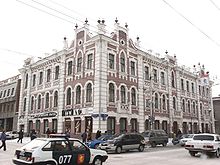Krasnoyarsk
![]()
The title of this article is ambiguous. For other meanings, see Krasnoyarsk (disambiguation).
Krasnoyarsk (Russian Красноярск, [![]()
![]() krəsnɐˈjarsk]) is a city in Russia on the Yenisei River and the Trans-Siberian Railway. With a population of 973,826 (as of 14 October 2010), Krasnoyarsk is the third largest city in Siberia after Novosibirsk and Omsk. It is the capital of the Krasnoyarsk region and is located about 3360 km east of Moscow.
krəsnɐˈjarsk]) is a city in Russia on the Yenisei River and the Trans-Siberian Railway. With a population of 973,826 (as of 14 October 2010), Krasnoyarsk is the third largest city in Siberia after Novosibirsk and Omsk. It is the capital of the Krasnoyarsk region and is located about 3360 km east of Moscow.
City breakdown
The city is divided into seven rajons (districts):
- Kirovski
- Leninsky
- Oktyabrsky
- Sovietsky
- Swerdlowski
- Zentralny
- Shelesnodoroshny
History
Krasnoyarsk was founded in 1628 as an ostrog (wooden fortress) by a Cossack unit as "Krasny Yar" (Beautiful or Red Steep Slope, derived from an earlier Turkic-language name of the place) by Andrei Dubensky to protect Yeniseysk from Kyrgyz attacks. The newly founded settlement was located four days' ride from Yeniseysk on the northern border of Kyrgyz settlements. The Kyrgyz attacked the new fortress but could not capture it. By 1690 Russia had finally annexed Siberia, and Krasnoyarsk was granted city rights. After the peace with Manchuria in 1728, Krasnoyarsk increasingly lost its strategic importance as a military outpost. Despite the future peaceful life, the city did not grow. A fire devastated almost the entire city in 1773, only 30 houses were spared. The population at the end of the 18th century was 850 men, 80% of whom were soldiers. In 1807 the founder of the Russian-American Trading Company Nikolai Resanov died of a cold in the city on his way back from California to St. Petersburg. On the presumed site of his burial place there is a tomb today.
On December 12, 1822 the Yeniseisk governorate came into being under the newly established General Governorate of Eastern Siberia (Governor General Lavinsky), whose capital was Krasnoyarsk. At that time a telephone station, elementary school, girls' high school, teachers' seminary, as well as a craftsmen's school were opened. Now to Krasnoyarsk moved merchants, craftsmen and owners of gold mines. The first stone buildings were erected, a park was laid out and a printing house was opened. With the construction of the Trans-Siberian Railway in 1895, which connected Krasnoyarsk with the centre of Russia, the city experienced an economic boom. On December 6, 1896, the first train of the Trans-Siberian Railway arrived in Krasnoyarsk. Three years later the railway bridge over the Yenisei (by Yevgeny Knorre and Lavrent Proskuryakov) was opened and Krasnoyarsk became the largest transport hub in Siberia.In 1897 Lenin was exiled to Siberia for three years, to Shushenskoye south of Krasnoyarsk.
Before the Second World War, 40,000 people lived in Krasnoyarsk. Due to evacuation of civilian population from the west of the Soviet Union during the war, as well as political exile, the city grew. Between 1938 and 1956, one million people were deported to the Krasnoyarsk region of western Siberia and used for forced labor. In 1941 the locomotive factory "Krasny Profintern", which had been transferred to Krasnoyarsk, started its work. Other war-prone industries were also transferred behind the Urals to Krasnoyarsk. In the course of the war years, the industrial capacity thus increased sevenfold, so that Krasnoyarsk overtook Irkutsk and became the industrial centre of Eastern Siberia. In September 1961 the first cubic meter of concrete was processed for the construction of the Krasnoyarsk Hydroelectric Power Plant and the Municipal Bridge (length: 2100 m) was put into operation. Construction of the Krasnoyarsk Metro began in the mid-1990s. In 1987 the October Bridge over the Yenisei was opened (length: 5000 m, width: 41 m).
Population development
| Year | Inhabitants |
| 1897 | 26.699 |
| 1939 | 189.977 |
| 1959 | 412.375 |
| 1970 | 648.113 |
| 1979 | 796.305 |
| 1989 | 912.629 |
| 2002 | 909.341 |
| 2010 | 973.826 |
Note: Census data

A historic house in Krasnoyarsk
Search within the encyclopedia